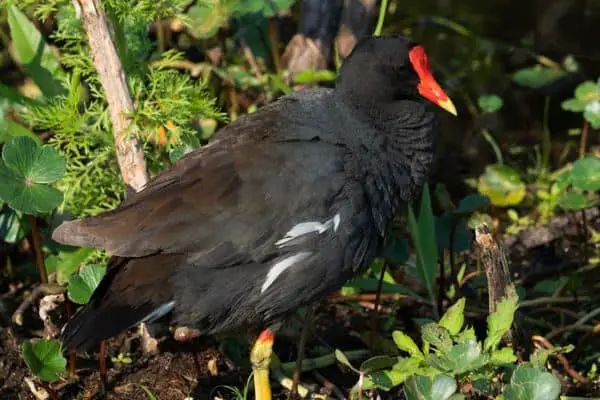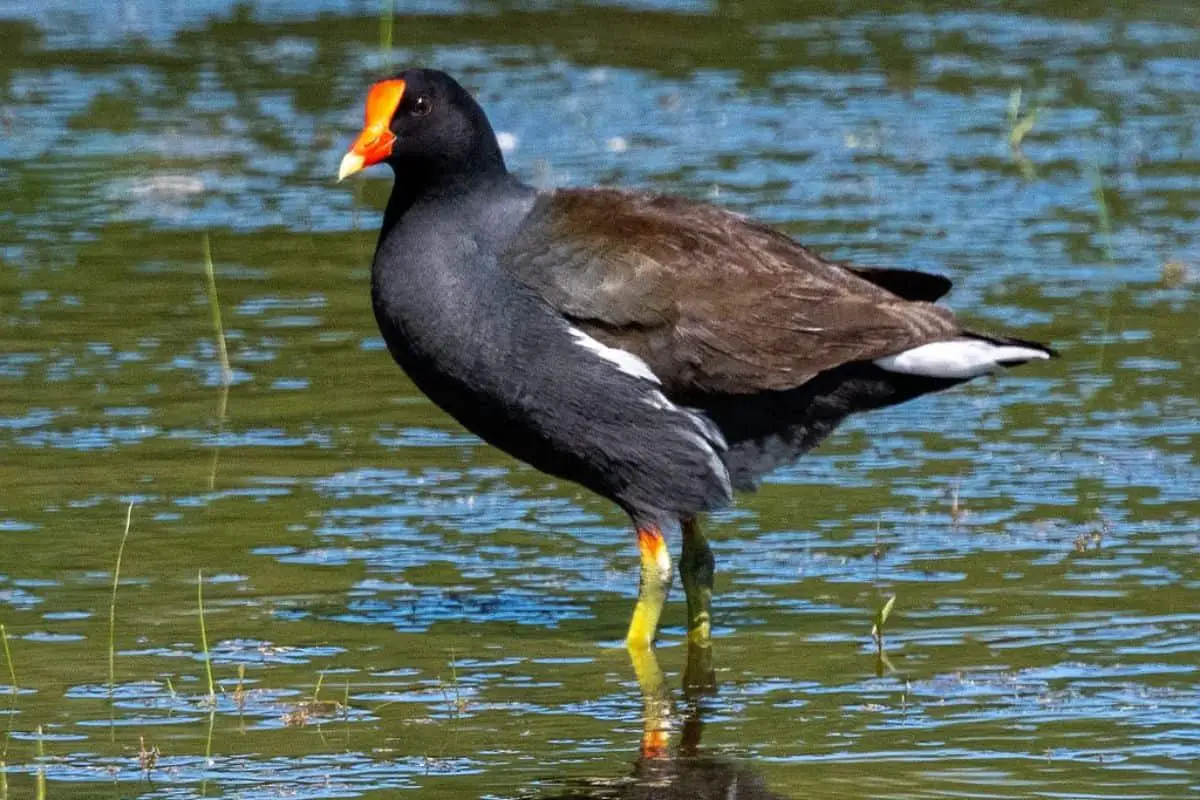Common Name: Common Gallinule
Scientific Name: Gallinula galeata| Size | Diet | Range in Hawaii | Status in Hawaii |
|---|---|---|---|
| 13 in - 15 in. | water lilies, pondweeds, sedges, and grasses | Common on all islands | Least Concern |
The Common Gallinule (Gallinula galeata), a bird species known for its distinctive red frontal shield and yellow-tipped bill, can be found in various parts of the world, including Hawaii. In fact, the Hawaiian subspecies of the Common Gallinule, known as the Hawaiian Gallinule (Gallinula galeata sandvicensis), is a unique and fascinating bird that has captured the attention of bird enthusiasts and scientists alike.
According to recent data, the Hawaiian Gallinule population has been declining, making it a species of conservation concern. In this article, we will explore the existence of the Common Gallinule in Hawaii, its current conservation status, and learn more about this captivating bird species.
Common Gallinule
Appearance

The Common Gallinule is a medium-sized bird with a distinct appearance. It measures approximately 13-15 inches in length. It has a black body with a dark gray back and undertail.
The head and neck are a rich, glossy dark green, with a red and yellow bill that has a white tip. The forehead and shield are pale blue, and the eyes are red.
The legs and feet are bright yellow, making them easily noticeable. The Common Gallinule also possesses a white undertail that becomes prominent when it spreads its tail feathers.
Diet
The diet of the Common Gallinule primarily consists of plant matter and aquatic vegetation. These birds are herbivores, feeding on a variety of aquatic plants, including water lilies, pondweeds, sedges, and grasses.
They also consume seeds, fruits, and agricultural crops when available. In addition to plant material, the Common Gallinule may occasionally feed on small aquatic invertebrates such as insects, snails, and small crustaceans.
They forage by picking or pecking at vegetation both above and below the water surface, using their long toes and partially webbed feet to move through marshes and wetlands. Their diet is adapted to their habitat, as they are well-suited to thrive in wetland environments where they can access their preferred food sources.
Nesting
The Common Gallinule builds its nest in aquatic vegetation, usually near the water’s edge in marshes, wetlands, or along the shores of lakes and ponds. The nest is a floating platform or a mound of vegetation, constructed using sticks, leaves, and other plant materials. The female gallinule takes the primary responsibility for nest building, while the male assists in gathering nesting materials.
The nest is typically located in dense vegetation, providing camouflage and protection for the eggs and young chicks. The female usually lays a clutch of 6-10 eggs, which are oval-shaped and have a light brown or tan color with dark speckles. Both parents take turns incubating the eggs, which usually hatch after about three weeks.
After hatching, the chicks are precocial, which means they are relatively independent and can swim and feed themselves shortly after emerging from the eggs. However, they still receive parental care and guidance.
The parents continue to protect and feed the chicks, teaching them how to forage for food and navigate through the marshy habitat. The chicks remain in the vicinity of the nest until they are able to fly, which occurs around 6-7 weeks after hatching.
Behavior

The Common Gallinule exhibits a fascinating range of behaviors suited for its wetland habitat. These birds are skilled at foraging, employing a unique walking technique that allows them to navigate on floating vegetation while searching for aquatic plants and other food sources.
With their long toes and partially webbed feet, they effortlessly move through marshes and wetlands, adeptly reaching both above and below the water surface to obtain their preferred meals.
Swimming is another remarkable behavior of the Common Gallinule. They glide gracefully through the water, utilizing their strong legs and lobed toes to propel themselves forward.
This ability enables them to access new foraging areas and escape potential threats. Moreover, they can dive briefly, plunging below the water’s surface to gather food or elude predators.
Socially, these birds demonstrate interesting behaviors as well. They often form small groups or pairs during the breeding season and engage in courtship displays.
Males and females work collaboratively to construct nests, with the female taking the lead while the male assists in gathering materials. Both parents take turns incubating the eggs, showcasing their shared responsibility in caring for their offspring.
The Common Gallinule’s behavior also includes territoriality, defending their preferred foraging and nesting areas from other individuals or species. They communicate using a range of vocalizations, including calls and a variety of squawks, to convey their intentions and establish dominance.
Habitat
The Common Gallinule is well adapted to a variety of wetland habitats. These birds are commonly found in marshes, swamps, lakes, ponds, and other freshwater or brackish water environments.
They thrive in areas with abundant vegetation, including emergent plants like cattails, bulrushes, and sedges, as well as floating vegetation such as water lilies and duckweeds. Their preferred habitats often have dense vegetation that provides cover and nesting sites.
They are frequently observed near the water’s edge, where they can easily access both land and water resources. These adaptable birds can inhabit different types of wetlands, including natural wetlands, reservoirs, and even man-made habitats like rice fields or retention ponds.
In addition to their dependence on vegetation, the Common Gallinule also requires open water for swimming, diving, and escaping potential threats. The interconnected network of marshes, ponds, and shallow water bodies provides the ideal balance of vegetation cover and open water spaces, offering both food and safety.
Range
The Common Gallinule is a non-native bird species that has been introduced to Hawaii. It is commonly found on all of the main Hawaiian islands.
Conservation Status

The conservation status of the Common Gallinule is generally considered to be of least concern. This means that the species is not currently facing significant threats that would warrant a higher level of conservation concern.
Common Gallinules have a broad distribution across their range, which includes various wetland habitats in North and South America, Europe, Africa, and parts of Asia. Their adaptability to different wetland environments has likely contributed to their stable population status.
Interesting Facts
1. Agile swimmers
Apart from being adept walkers, Common Gallinules are skilled swimmers. They can gracefully glide through water, propelling themselves using their strong legs and partially webbed feet.
2. Colorful beak
The bill of the Common Gallinule is an eye-catching combination of red, yellow, and green with a white tip. This unique coloration adds to their striking appearance.
3. Widespread range
Common Gallinules have a global presence, inhabiting wetland habitats across several continents, including North and South America, Europe, Africa, and parts of Asia.
4. Feathery Feet
The Common Gallinule has long toes with lobes of skin on their feet that act like paddles, enabling them to walk on floating vegetation and navigate through marshes with ease.
Frequently Asked Questions
1. Do Common Gallinules migrate?
While some populations of Common Gallinules are migratory, the species as a whole displays both migratory and non-migratory behaviors. Migration patterns may vary depending on geographic location and availability of suitable habitats.
2. Are Common Gallinules social birds?
Yes, Common Gallinules can be social birds, particularly during the breeding season. They may form small groups or pairs and engage in courtship displays, cooperative nest building, and shared incubation duties.
3. Can the Common Gallinule fly?
Yes, the Common Gallinule is capable of flight. However, it is known for its preference for walking and swimming rather than prolonged flights. They primarily use their wings for short-distance flights to escape danger or reach different foraging areas.
4. Are Common Gallinules monogamous?
Common Gallinules typically form monogamous pairs during the breeding season. However, there have been cases of multiple mates or temporary pairings observed in certain populations.




